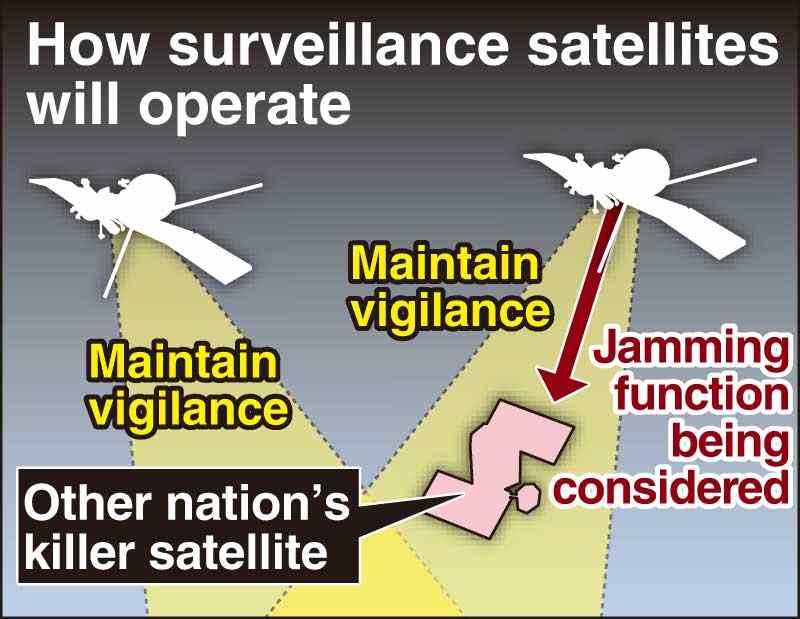
6:00 JST, October 31, 2022
To reinforce vigilance in outer space above Japan, the Defense Ministry has formulated a policy of putting into operation two surveillance satellites. It is also considering adding a function to the second satellite to interfere with the activities of Chinese and Russian killer satellites in orbit, several government sources said.
A killer satellite is a military satellite that can attack other nations’ satellites in outer space. It approaches the target satellite and captures it with its robotic arms or bombards it with electromagnetic waves to disable it.
Since 2010, China has repeatedly conducted tests to move satellites closer together, while Russia is also said to be developing related technology.
The establishment and expansion of a surveillance satellite system will be specified in the National Defense Program Guidelines and the Medium Term Defense Program, both of which will be revised by the end of the year, as one of the pillars of measures to strengthen Japan’s defense capabilities in outer space.
The surveillance satellites will be put into geostationary orbit at an altitude of about 36,000 kilometers. Each will be equipped with an optical telescope to collect information on the movements of killer satellites and the like. Vigilance via ground-based radar is scheduled to begin in the next fiscal year, but more detailed data can be obtained in outer space.
Currently, it has been confirmed that the first unit will be launched by FY2026. However, with the operation of one unit alone, there is a limit in the range of surveillance covered, depending on the angle of the sensor. To cover the entire sky over Japan, multiple satellites are needed. The ministry will verify the operation of the first satellite and then coordinate the timing of the launch of the second satellite.
The need for surveillance satellites was first put forth in the National Defense Program Guidelines and the Medium Term Defense Program for 2018 in response to the development of killer satellites by China and Russia.
As for Japan’s security-related satellites, ones for positioning essential for guiding a missile to its intended target and information-gathering satellites that monitor movements on the ground are among those in operation. If these satellites were incapacitated by a killer satellite, Japan’s defense would be seriously impacted.
For this reason, the second surveillance satellite will be equipped with a jamming device to prevent an attack by a killer satellite. The ministry will begin concrete design work in the next fiscal year.
Regarding attacks on killer satellites, Defense Minister Yasukazu Hamada indicated during a House of Representatives National Security Committee held on Thursday that it is legally possible.
“It must be a measure deemed the minimum necessary for our self-defense,” Hamada said. “We will make a decision based on the specific circumstances of each case.”
"Politics" POPULAR ARTICLE
-

Japan to Support Central Asian Logistics Route That Bypasses Russia, Plan to Be Part of Upcoming Summit in Tokyo
-

Japan to Tighten Screening of Foreigners’ Residential Status by Providing Information of Nonpayment of Taxes
-

Chinese, Russian Bombers Flew Unusual Path by Heading Toward Tokyo; Move Likely Meant to Intimidate Japan
-

Japan Plans National Database to Track Foreign Ownership of Real Estate, Land as It Weighs New Rules
-

Up to 199,000 Deaths Estimated From Mega-Tsunami; Most Recent Occurrence Took Place in 17th Century
JN ACCESS RANKING
-

Tokyo Economic Security Forum to Hold Inaugural Meeting Amid Tense Global Environment
-

Keidanren Chairman Yoshinobu Tsutsui Visits Kashiwazaki-Kariwa Nuclear Power Plant; Inspects New Emergency Safety System
-

Imports of Rare Earths from China Facing Delays, May Be Caused by Deterioration of Japan-China Relations
-

University of Tokyo Professor Discusses Japanese Economic Security in Interview Ahead of Forum
-

Japan Pulls out of Vietnam Nuclear Project, Complicating Hanoi’s Power Plans


























